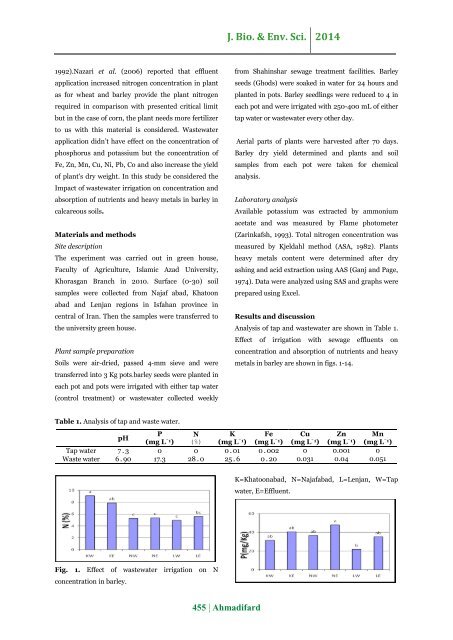Impact of wastewater irrigation on concentration and absorption of nutrients and heavy metals in barley in calcareous soils
Abstract In arid and semiarid regions such as Iran, wastewater reuse can be a means to compensate for the lack of water. The use of refined wastewater in agriculture will reduce the use of agriculture water that it can be used for other purpose such as drinking. A study was carried out to investigate the effect irrigation with wastewater effluent on concentration and absorption of nutrients and heavy metals in barley grown in the calcareous soils. Surface soil samples (0-30 cm) were collected from Najafabad, Khatoonabad and Lenjan areas in Isfahan province, Iran.A pot experiment consisted of 2 irrigation treatments including irrigation with tap water and with wastewater and 3 soils was conducted in the green house. Plants were grown in pots and they were irrigated with urban water effluent for 70 days. Plant samples were analyzed after barley harvest. Selected nutrients and heavy metals concentration and absorption were also determined in barley. Irrigation with waste water increase concentration and absorption of phosphorus (P), iron (Fe) and zinc (Zn) in barley.
Abstract
In arid and semiarid regions such as Iran, wastewater reuse can be a means to compensate for the lack of water. The use of refined wastewater in agriculture will reduce the use of agriculture water that it can be used for other purpose such as drinking. A study was carried out to investigate the effect irrigation with wastewater effluent on concentration and absorption of nutrients and heavy metals in barley grown in the calcareous soils. Surface soil samples (0-30 cm) were collected from Najafabad, Khatoonabad and Lenjan areas in Isfahan province, Iran.A pot experiment consisted of 2 irrigation treatments including irrigation with tap water and with wastewater and 3 soils was conducted in the green house. Plants were grown in pots and they were irrigated with urban water effluent for 70 days. Plant samples were analyzed after barley harvest. Selected nutrients and heavy metals concentration and absorption were also determined in barley. Irrigation with waste water increase concentration and absorption of phosphorus (P), iron (Fe) and zinc (Zn) in barley.
You also want an ePaper? Increase the reach of your titles
YUMPU automatically turns print PDFs into web optimized ePapers that Google loves.
J. Bio. & Env. Sci. 2014<br />
1992).Nazari et al. (2006) reported that effluent<br />
applicati<strong>on</strong> <strong>in</strong>creased nitrogen c<strong>on</strong>centrati<strong>on</strong> <strong>in</strong> plant<br />
as for wheat <strong>and</strong> <strong>barley</strong> provide the plant nitrogen<br />
required <strong>in</strong> comparis<strong>on</strong> with presented critical limit<br />
but <strong>in</strong> the case <str<strong>on</strong>g>of</str<strong>on</strong>g> corn, the plant needs more fertilizer<br />
to us with this material is c<strong>on</strong>sidered. Wastewater<br />
applicati<strong>on</strong> didn’t have effect <strong>on</strong> the c<strong>on</strong>centrati<strong>on</strong> <str<strong>on</strong>g>of</str<strong>on</strong>g><br />
phosphorus <strong>and</strong> potassium but the c<strong>on</strong>centrati<strong>on</strong> <str<strong>on</strong>g>of</str<strong>on</strong>g><br />
Fe, Zn, Mn, Cu, Ni, Pb, Co <strong>and</strong> also <strong>in</strong>crease the yield<br />
<str<strong>on</strong>g>of</str<strong>on</strong>g> plant's dry weight. In this study be c<strong>on</strong>sidered the<br />
<str<strong>on</strong>g>Impact</str<strong>on</strong>g> <str<strong>on</strong>g>of</str<strong>on</strong>g> <str<strong>on</strong>g>wastewater</str<strong>on</strong>g> <str<strong>on</strong>g>irrigati<strong>on</strong></str<strong>on</strong>g> <strong>on</strong> c<strong>on</strong>centrati<strong>on</strong> <strong>and</strong><br />
absorpti<strong>on</strong> <str<strong>on</strong>g>of</str<strong>on</strong>g> <strong>nutrients</strong> <strong>and</strong> <strong>heavy</strong> <strong>metals</strong> <strong>in</strong> <strong>barley</strong> <strong>in</strong><br />
<strong>calcareous</strong> <strong>soils</strong>.<br />
Materials <strong>and</strong> methods<br />
Site descripti<strong>on</strong><br />
The experiment was carried out <strong>in</strong> green house,<br />
Faculty <str<strong>on</strong>g>of</str<strong>on</strong>g> Agriculture, Islamic Azad University,<br />
Khorasgan Branch <strong>in</strong> 2010. Surface (0-30) soil<br />
samples were collected from Najaf abad, Khato<strong>on</strong><br />
abad <strong>and</strong> Lenjan regi<strong>on</strong>s <strong>in</strong> Isfahan prov<strong>in</strong>ce <strong>in</strong><br />
central <str<strong>on</strong>g>of</str<strong>on</strong>g> Iran. Then the samples were transferred to<br />
the university green house.<br />
Plant sample preparati<strong>on</strong><br />
Soils were air-dried, passed 4-mm sieve <strong>and</strong> were<br />
transferred <strong>in</strong>to 3 Kg pots.<strong>barley</strong> seeds were planted <strong>in</strong><br />
each pot <strong>and</strong> pots were irrigated with either tap water<br />
(c<strong>on</strong>trol treatment) or <str<strong>on</strong>g>wastewater</str<strong>on</strong>g> collected weekly<br />
from Shah<strong>in</strong>shar sewage treatment facilities. Barley<br />
seeds (Ghods) were soaked <strong>in</strong> water for 24 hours <strong>and</strong><br />
planted <strong>in</strong> pots. Barley seedl<strong>in</strong>gs were reduced to 4 <strong>in</strong><br />
each pot <strong>and</strong> were irrigated with 250-400 mL <str<strong>on</strong>g>of</str<strong>on</strong>g> either<br />
tap water or <str<strong>on</strong>g>wastewater</str<strong>on</strong>g> every other day.<br />
Aerial parts <str<strong>on</strong>g>of</str<strong>on</strong>g> plants were harvested after 70 days.<br />
Barley dry yield determ<strong>in</strong>ed <strong>and</strong> plants <strong>and</strong> soil<br />
samples from each pot were taken for chemical<br />
analysis.<br />
Laboratory analysis<br />
Available potassium was extracted by amm<strong>on</strong>ium<br />
acetate <strong>and</strong> was measured by Flame photometer<br />
(Zar<strong>in</strong>kafsh, 1993). Total nitrogen c<strong>on</strong>centrati<strong>on</strong> was<br />
measured by Kjeldahl method (ASA, 1982). Plants<br />
<strong>heavy</strong> <strong>metals</strong> c<strong>on</strong>tent were determ<strong>in</strong>ed after dry<br />
ash<strong>in</strong>g <strong>and</strong> acid extracti<strong>on</strong> us<strong>in</strong>g AAS (Ganj <strong>and</strong> Page,<br />
1974). Data were analyzed us<strong>in</strong>g SAS <strong>and</strong> graphs were<br />
prepared us<strong>in</strong>g Excel.<br />
Results <strong>and</strong> discussi<strong>on</strong><br />
Analysis <str<strong>on</strong>g>of</str<strong>on</strong>g> tap <strong>and</strong> <str<strong>on</strong>g>wastewater</str<strong>on</strong>g> are shown <strong>in</strong> Table 1.<br />
Effect <str<strong>on</strong>g>of</str<strong>on</strong>g> <str<strong>on</strong>g>irrigati<strong>on</strong></str<strong>on</strong>g> with sewage effluents <strong>on</strong><br />
c<strong>on</strong>centrati<strong>on</strong> <strong>and</strong> absorpti<strong>on</strong> <str<strong>on</strong>g>of</str<strong>on</strong>g> <strong>nutrients</strong> <strong>and</strong> <strong>heavy</strong><br />
<strong>metals</strong> <strong>in</strong> <strong>barley</strong> are shown <strong>in</strong> figs. 1-14.<br />
Table 1. Analysis <str<strong>on</strong>g>of</str<strong>on</strong>g> tap <strong>and</strong> waste water.<br />
pH<br />
P N K Fe Cu Zn Mn<br />
(mg L - 1<br />
) )%( (mg L - 1<br />
) (mg L - 1<br />
) (mg L - 1<br />
) (mg L - 1<br />
) (mg L - 1<br />
)<br />
Tap water 7.3 0 0 0.01 0.002 0 0.001 0<br />
Waste water 6.90 17.3 28.0 25.6 0.20 0.031 0.04 0.051<br />
K=Khato<strong>on</strong>abad, N=Najafabad, L=Lenjan, W=Tap<br />
water, E=Effluent.<br />
Fig. 1. Effect <str<strong>on</strong>g>of</str<strong>on</strong>g> <str<strong>on</strong>g>wastewater</str<strong>on</strong>g> <str<strong>on</strong>g>irrigati<strong>on</strong></str<strong>on</strong>g> <strong>on</strong> N<br />
c<strong>on</strong>centrati<strong>on</strong> <strong>in</strong> <strong>barley</strong>.<br />
455 | Ahmadifard





![Review on: impact of seed rates and method of sowing on yield and yield related traits of Teff [Eragrostis teff (Zucc.) Trotter] | IJAAR @yumpu](https://documents.yumpu.com/000/066/025/853/c0a2f1eefa2ed71422e741fbc2b37a5fd6200cb1/6b7767675149533469736965546e4c6a4e57325054773d3d/4f6e6531383245617a537a49397878747846574858513d3d.jpg?AWSAccessKeyId=AKIAICNEWSPSEKTJ5M3Q&Expires=1715403600&Signature=X%2FNts64kAAsv0EM0vk9%2Bb1xH%2FD4%3D)












